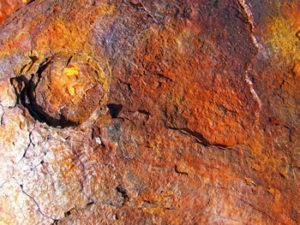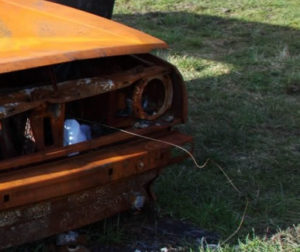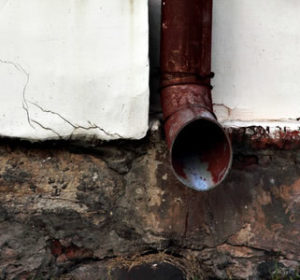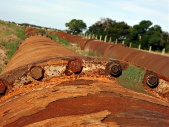What is Rust and where is it Common
 Rusting is the process in which iron or steel corrodes, everyone should understand how rust forms and where to look for it in your home/business.
Rusting is the process in which iron or steel corrodes, everyone should understand how rust forms and where to look for it in your home/business.
Rusting takes place when iron is in continuous contact with oxygen, the process is called oxidation. The oxygen that causes rust is delivered in water, either in its liquid state or gaseous (water vapor/fog). The carbon dioxide in the air in combination with the water creates a carbonic acid, this breaks down the water to its molecular state (hydrogen and oxygen), and this also causes some of the iron in the metal to dissolve. The oxygen molecules bond to the dissolved iron creating iron oxide (rust). There are certain catalyst to the rusting process (speeding it up), these include: salt water, acid and acid rains, soil, and gaseous sulfur compounds. Any architectural cracks and crevices will hold water and will accelerate the rusting process.
It is also beneficial to understand what kind of metals is susceptible to rust, and how to identify them. Any iron, or iron alloy like steal (including stainless and galvanized) will be susceptible to rust. Now this is not to say that other metals won’t corrode, but they will not rust. Iron is typically dark in color and it is magnetic, all of its alloys have the same magnetic property so if you are unsure, for the most part if it is magnetic and in your home it can rust.
The first area that rust is commonly found in a home is the foundation. Now you may thing that the foundation is just concrete, that is not the case though, and when a foundation is poured the use of steel rebar to reinforce the concrete is common. Now in most cases the concrete effectively entombs the rebar, however if the concrete is not sealed correctly moisture will penetrate into it, and in doing so it will begin the rusting process of the rebar sub-structure. This can be very difficult to spot because you cannot see the rebar, what you can see is the surface of the concrete, it is important to inspect the concrete for weak spots. Any cracks or chips in the concrete will be an easy point of entry for moisture to get to the rebar and begin the rusting process. This can be without a doubt the most costly; it is a time consuming and labor intensive process.
Another area in a home where rust is common is on the roof, especially roofs that are steel. This most commonly happens when a steel roof is coated with a sealer without first being cleaned and scraped, the result is moisture trapped under the sealer leading to rust issues. This is not the only type of roofing that can be susceptible to rust though. Another common occurrence is when the nails used to install shingles or similar product rust. This leads to single shingles or even whole sections peeling away. Other areas that should be inspected regularly are: fuel oil tanks, hot water heaters, fences/railings, and electrical panels.
The Annual Cost of Vehicle Corrosion
 When you think about motor vehicle corrosion, you may picture an old rusted-out “beater” from the 1970s. Thanks to major improvements in manufacturing and prevention, visible corrosion isn’t as much of a problem for today’s cars, but corrosion does still cause serious damage to motor vehicles every year.
When you think about motor vehicle corrosion, you may picture an old rusted-out “beater” from the 1970s. Thanks to major improvements in manufacturing and prevention, visible corrosion isn’t as much of a problem for today’s cars, but corrosion does still cause serious damage to motor vehicles every year.
Corrosion causes a whole host of problems in motor vehicles, from unsightly rust on the body panels to the wearing out of electrical components, all the way up to sudden brake failures that can result in serious accidents.
The harmful effects of corrosion on motor vehicles cost billions of dollars every year. In fact, according to a 2013 study by NACE International, the total cost of corrosion in all industries worldwide is estimated at approximately $2.5 trillion. That’s almost 3.5% of the entire world’s GDP!
In the United States, corrosion in all industries, including infrastructure, utilities, and manufacturing as well as transportation, costs approximately $276 billion per year, according to a study commissioned by the U.S. Federal Highway Administration (FHWA).
Additionally, the U.S. Department of Defense had a study performed in 2011 on the cost of corrosion for Army ground vehicles. That study found corrosion was costing the Army about $1.6 billion annually, which was over 12% of the total amount that the Army spent on maintenance for those vehicles.
Obviously, corrosion is a serious and expensive problem. Let’s take a look at why that is and exactly how much motor vehicle corrosion actually costs us per year.
What is Corrosion?
The FHWA describes corrosion as “a naturally occurring phenomenon commonly defined as the deterioration of a substance (usually a metal) or its properties because of a reaction with its environment.”
In other words, corrosion is the rusting or breakdown of materials caused by exposure to outside substances like water, salt, de-icing solutions, acid rain, and other chemicals. One of the biggest causes of corrosion for motor vehicles is the salting of roads in the winter, but cars driven in warmer climates suffer damage from corrosion too.
Damage from Corrosion
Corrosion damages motor vehicles in several different ways, which can be both costly and dangerous. For instance, in 2011, the U.S. National Highway Traffic and Safety Administration (NHTSA) began an investigation due to reports of mysterious and sudden brake failures that had caused over 100 crashes.
What the NHTSA ultimately found was that the failures weren’t caused by any defect in the manufacturing of the cars. Instead, the sudden brake failures were caused by corrosion of the brake lines due to long-term exposure to salt and other de-icing chemicals.
Another example of corrosion damage that’s less dangerous than brake failure but still a potential hazard: In 2014, Toyota Canada recalled nearly 100,000 minivans due to a corrosion problem. The design of the minivan allowed water from the roadway to splash up where the spare tire was connected to the vehicle.
The salt brine from the de-iced roads corroded the metal holding the spare tire in place. As a result, the spare tires were falling off of the minivans!
Other components of motor vehicles that are particularly susceptible to corrosion include the exhaust system, the radiator, the frame, and the suspension. But electrical components, fuel tanks, and other parts can be damaged as well.
The Costs of Corrosion
Several estimates have been made of the costs of corrosion for motor vehicle owners. As the 2002 FHWA report explains, these costs include not only the cost of repairs, but also the increased cost of manufacturing vehicles that are corrosion-resistant and the depreciation of the vehicles due to corrosion damage.
For instance, in 2016, the non-profit advocacy organization AAA performed a survey looking at the cost of repairing damage due to corrosion. What they found was that U.S. automobile owners had spent approximately $15.4 billion over the previous five years to repair rust damage caused by de-icing salts and chemicals.
That’s an annual cost of about $3 billion just to repair corrosion from de-icing. The Transportation Research Board estimates that about half of corrosion damage is caused by de-icing, while the rest is caused by other culprits such as acid rain and marine environments. That suggests the total annual cost of corrosion-related repairs might be closer to $6 billion.
In fact, the 2002 FHWA report estimated the annual cost of all corrosion-related motor vehicle repairs right at $6.45 billion.
The 2002 FHWA report didn’t just look at the cost of repairs—they also studied the broader range of the costs related to corrosion. After consulting with automobile manufacturers, they estimated the increased cost of manufacturing corrosion-resistant cars at about $150 per new vehicle. That worked out to $2.5 billion per year as of 2002.
Furthermore, the FHWA estimated the cost of corrosion-related depreciation in higher and lower-corrosion areas in the 1990s. They found that corrosion reduced the value of cars in the higher-corrosion areas by about $140 per year and in lower-corrosion areas by about $110 per year.
Of course, due to inflation, those numbers are probably higher today. Overall, the FHWA found that corrosion-related depreciation costs about $14.4 billion per year.
Ultimately, the FHWA report estimated the total cost of motor vehicle corrosion at $23.4 billion annually. Given that there were approximately 200 million motor vehicles on the roads in the U.S. at the time of the report, the cost of corrosion comes out to an average of $117 per vehicle every year.
The Correlation between Rust and Tetanus
A potentially lethal medical condition, tetanus (Clostridium Tetani) lies in wait in non-other than ordinary soil. The correlation between rust and tetanus is actually attributed to the ability of this soil to be trapped in the porous surface of the rust. This is why many times people will talk about stepping on a rusty nail, it is not actually the rust that causes the issue but the bacterial trapped on the surface. Clostridium Tatani is dormant when exposed to oxygen and does not become active until it enters the body. Once in the body it rapidly begins producing a neurotoxin called tetanospasm.
This neurotoxin (a substance that is damaging or poisonous to nerve tissue) is the cause of the symptoms that come with Tetanus, including: muscle spasms (which is where the term Lockjaw comes from), difficulty swallowing, and fever. While there is a very real risk of tetanus, the fear associated with cuts from rusty metal is often exaggerated. Cases of tetanus are extremely rare, with .15 cases in 1,000,000 people living in the U.S.A. Part of the reason that it is so rare in the states is the immunization that is readily available. However keep in mind that if you have not received the vaccination it very important to be careful, especially where the elderly, or infants are concerned. Tetanus can be found on any object that has come in contact with contaminated soil. This includes but is not limited to; metal objects (even if it is not rusty), plastic items, glass, almost anything that has come in contact with the soil can be a source of Clostridium tetani. That is the real correlation to be made, rust doesn’t cause tetanus, and it only offers a viable median to transmit the bacterium that causes the illness.
Pipe Corrosion
In the United States alone corrosion costs us more than a billion dollars a year. Copper corrosion in the household plumbing systems can cost many hundreds of dollars per year. Aside from causing the pipes to fail, copper corrosion can cause damage to the household , leaving blue stains anywhere that it touches.
If there are copper pipes in a household, copper corrosion can cause tinting of the laundry and can even cause blonde or light colored hair to be tinted blue. Iron pipes can corrode and cause the pipe to simply stop working, in many cases in well under ten years time you’ll have to revamp the household piping
What is Corrosion?
Corrosion is a deterioration of something due to reacting with its environment. In very simple terms, the metal from the pipe simply dissolves because of a reaction to the water or to other environmental factors.
What Causes Corrosion?
The main causative agents of pipe corrosion in the United States are low ph or acidic water that is typically found in well water, though it may also be a problem found in municipal water systems.
The water may be running at high velocity due to smaller pipe diameter and for this reason can cause a problems with the piping that is actually wearing down.
Poor plumbing may also be a part of the problem for corrosion in the household.
The fix of course for the corrosion is to correct the problem that is causing the corrosion and to replace those pipes and other items that have become corroded. Identify the source by investigating all of those things that could possibly be causing a problem. Raise the pH if needed and check to see if the water is still corrosive as well as checking to see if anything electrical has been connected to the piping and that it has continuity.
Corrosion can cost you plenty. Making sure that you nip it in the bud is always the best option.
Removing Rust from a Rain Gutter
 Certain types of rain gutters will rust. If not removed, the rust will mean replacing the gutters sooner than would be necessary. Prevention, including cleaning, is the best solution but rust does happened and needs to be treated before further corrosion occurs. You could call someone to do the job for you but you can take care of it yourself. To do this, you will need sandpaper and paint specially made for rain gutters. A siding or roofing supply store should have what you need. So you are prepared and do not need to make additional trips, purchase new straps and new sealant for the elbows. It is a good idea to see if you can tell if any parts have enough rust to require replacement parts so you will have them ready when needed.
Certain types of rain gutters will rust. If not removed, the rust will mean replacing the gutters sooner than would be necessary. Prevention, including cleaning, is the best solution but rust does happened and needs to be treated before further corrosion occurs. You could call someone to do the job for you but you can take care of it yourself. To do this, you will need sandpaper and paint specially made for rain gutters. A siding or roofing supply store should have what you need. So you are prepared and do not need to make additional trips, purchase new straps and new sealant for the elbows. It is a good idea to see if you can tell if any parts have enough rust to require replacement parts so you will have them ready when needed.
This job normally only takes a couple of days. You will need to dismantle the downspouts through which the water drains from the troughs that catch the rainwater. Because the troughs are more difficult to put back on place, it is best to leave them where they are and clean the rust from them there. The downspouts are more easily reinstalled.
Remove the straps that hold the downspouts in place so the spouts are not secured to the side of the house. It is best to leave the elbow that connects the downspout to the trough in place since it is sealed to the trough. Sand to rust until no more rust is visible; normally rust is only on the surface of the metal. Should you sand all the way through without removing all the rust, the metal will have lost integrity and you will need to replace that part of the gutter.
After you have sanded away the rust, paint the gutters to keep them from beginning to rust again right away. after the paint has dried, reinstall the downspouts to the elbows. Inspect the sealant that holds the elbows to the troughs and if necessary, apply new sealant made for the purpose. If the straps can be reused, reattach them to secure the downspouts in place, starting at the top and working downward. It may be necessary to replace them but, fortunately, the straps do not cost much to replace.
With your rain gutters resurfaced and painted, you will not have to worry about them rusting through so water drips off the roof and goes where it could cause damage. Doing it yourself may take some time but will save money.
Rust Prevention and Removal
There are many ways that you can prevent rust in your home, the simplest way is to use metal products that are designed to be rust resistant.
One of the simplest ways to prevent rust is the use of galvanized products. Galvanized steel has been coated with zinc or cadmium, which provides resistance against rusting. Fasteners, I.E: nuts, bolts, nails, brackets, hangers etc. that are going to be used outside, or in a damp area of your home, should be galvanized. Galvanized fasteners are available in any home improvement store or hardware store. These products are easy to identify by the matte grey coating that they have on them. It is important to realize, that while galvanization prevents rust, the coating will wear off over time, particularly at the seams and joints where the coating has been compromised.
Another common product that is available that will save you the headache of rust issues is stainless steel. This is another option for the aforementioned fasteners that are used in the home. Stainless steel is steel that is impregnated with chromium; this serves the same purpose as the zinc on galvanized steel. However because the chromium is mixed in with the steel during manufacturing it cannot be worn away. Stainless steel is quite a bit pricier than the galvanized option
.However if you do not want to use galvanized or stainless steel there is another option. Coatings and paints will form a barrier between iron/steel and the moisture that will cause rust. Oiling steel or iron is a common coating method used to prevent or slow the formation of rust. For metal products inside your home or basement a simple way to prevent rust is to keep the relative humidity below 50%. This is a fairly simple process through the use of a dehumidifier. If you live in a coastal region rust can be even more of an issue, the salt that is found in the spray from the ocean will accelerate the rusting process rapidly. The only thing that can really be done about this is to clean the metal regularly. Washing off the salt residue will help to slow the formation of rust.
You should always make sure to do everything in your power to prevent rust, because it is extremely hard to stop the rusting process once it has begun. There are ways to remove the rust if it is too late though. Most professionals in the industry recommend scraping or wire brushing the metal as a simple way to remove the rust. Also sanding or low pressure sand blasting will effectively remove the rust, with either of these methods it is necessary to use caution to not go to deep past the rust layer, you don’t want to wear away at the good steel beneath. Once the rust has been cleaned up the use of rust inhibiting primer or paint will effectively slow the future formation of rust on the material. There are many effective ways of removing rust, but again the best way to prevent rust is to take the proper precautions.
Protecting Your Home from Rot with Gutter Repairs
Protecting Your Home with Gutter Repairs
Your gutters make up one of the most important aspects of your home exterior. Leak protection, water flow, and completing the look of your roof all comes down to your gutters. Because of this, it’s important to make sure that your gutters are well maintained and free of blockages at all times.
Gutters that are leaking, sagging, or even broken can lead to inadequate drainage and even bigger problems including rust and rot. Repairing and cleaning your gutters will not only protect the structure of your home, but also the surrounding soil, plants, trees, and pavements.
Common Aluminum Gutter Repairs
Aluminum gutters are long lasting, strong, and resilient to environmental damage. However this is not to say that they are impervious to problems.
Aluminum gutters can sometimes fail at the seals when debris has built up and allowed sealant to deteriorate. This can lead to leaks. This problem can be easily repaired by clearing the gutters of any debris and resealing them. Through this process your gutters will be as good as new.
Sometimes blockages may be so severe that gutters end up overflowing. This type of blockage can be serious if not seen to promptly. Overflowing water may enter your roof, or cause erosion damage to nearby gardens and soil. Leaves, dirt, tree limbs, and even children’s toys could be causing blockages. A professional exterior contractor will be able to clear the debris that’s causing the problem, clean and inspect your gutters, and finally reseal the gutter where required. An easy way to avoid blockages that lead to overflowing is to install gutter cover systems. These mesh covers allow your gutters to work flawlessly without allowing debris and other objects to enter the system.
Hail damage is also common, but is rarely structurally destructive. You can spot hail damage from the ground in the form of indentations and small dings. If the hail has completely punctured your gutters, you’ll need to get a professional in immediately. After any particularly bad hailstorm it’s best to have a specialist inspect your gutters for damage that could lead to future problems.
Loose, Fallen, and Sagging Gutters
In extreme circumstances your gutter could move, begin to sag, or even completely separate from the mounting spikes. This can occur after particularly harsh weather, when leakages and blocks aren’t attended to, or after the home expands and contracts due to seasonal changes.
Regularly maintaining your gutter is the best way to avoid costly gutter repairs and reinstallations.
Repairing Rusty Gutters
Steel guttering is more at risk of corrosion than modern aluminum solutions. Aluminum gutters are assembled on-site to create a seamless gutter. Unfortunately, the same is not true for older gutters.
Repairs on galvanized steel gutters are only a temporary solution, and aren’t recommended. Some contractors may offer touch ups with priming and repainting, but after time you’re going to be facing the same problem again as corrosion sets in and turns to rust. In this situation it’s best to replace your gutters, with aluminum gutters providing protection for the lifetime of your home.
Maintaining your gutters and making repairs when necessary will ensure that your seamless aluminum gutters are always working to protect your home. After storm inspection, unblocking, resealing, or even installation of mesh gutter covers are all small investments that will benefit your home for many years to come.
